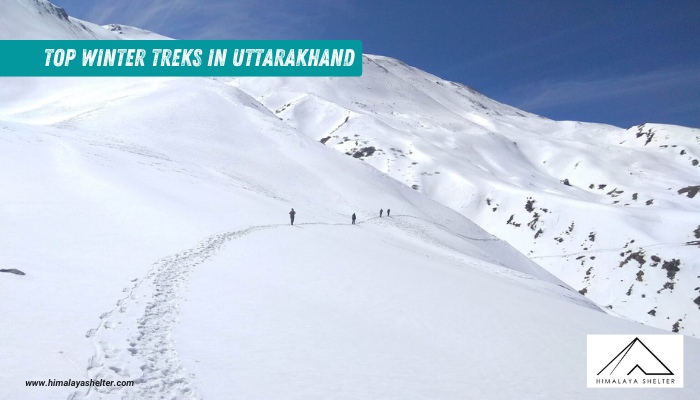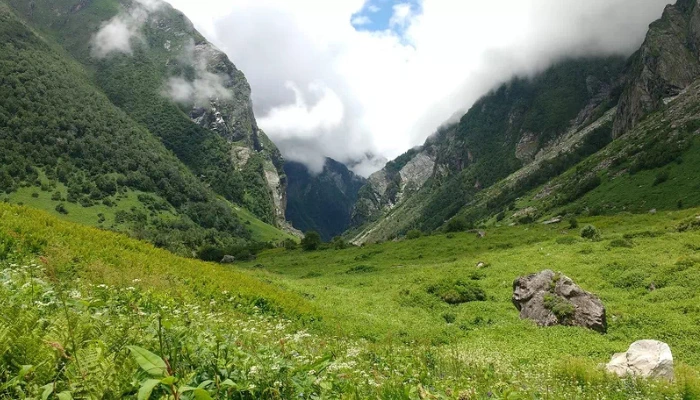
Kagbhusandi Lake Trek
TREK DIFFICULTY
Difficult
TREK DURATION
7 Days
HIGHEST ALTITUDE
5228meters
GROUP SIZE
12
TREK DISTANCE
60 km
BASECAMP
Uttarakhand
BEST TIME
June, July, September and October
PICKUP POINT
Dehradun (Prince Chowk)
Kagbhusandi Lake Trek
The Kagbhusandi Lake trek is a hidden gem for those seeking an escape into the lap of nature. This enchanting journey takes you through a picturesque landscape of lush meadows, ancient forests, and pristine glacial lakes.
The adventure begins in the quaint village of Bhyundar, which is easily accessible from the popular town of Joshimath in Uttarakhand, India. From Bhyundar, a scenic trail leads you into the heart of the mountains.
The Kagbhusandi Lake trek is considered moderate in difficulty, making it suitable for both beginners and experienced trekkers. The path is well-marked, and the gradual inclines allow for a comfortable pace. It's important to acclimatize and maintain a steady rhythm to fully enjoy the journey.
As you ascend, you'll be greeted by a diverse range of flora and fauna. Towering pines, rhododendrons, and ancient oaks provide a rich canopy, while vibrant wildflowers carpet the meadows in a riot of colors. Keep an eye out for playful Himalayan birds and elusive wildlife.
One of the highlights of this trek is the enchanting forest section. Tall trees create a natural cathedral, their roots forming gnarled archways. Sunlight filters through the leaves, casting dappled patterns on the forest floor, creating a mesmerizing play of light and shadow.
History of Kagbhusandi Lake Trek
The name 'Kagbhusandi' has been derived from Sanskrit word. 'Kag' means crow and 'Bhushundi' was the name of a famous sage. Sage Bhushundi was called as 'Kagbhusandi' because he was cursed to be reborn as a crow. According to Hindu mythology, Kagbhusandi was a great devotee but later he became an arrogant sage. Being proud of him he insulted Lord Shiva. Then he was cursed by another sage to become a crow in his next birth.
However, later Lord Shiva forgave him and blessed him with immortality and immense spiritual wisdom. Thereafter he chose to stay near this solitary lake and meditate. He meditated here for years and recounted divine stories to people.
In the Ramcharitmanas, Tulsidas depicted Kagbhusandi as a great devotee of Lord Rama. Kagbhusandi was the one who narrated Ramayana to Garuda, the king of birds. It is believed that since Kagbhusandi has spent a long time near the lake and narrated thousands of divine stories, this is why the lake has received such a radiant and spiritual aura.
The Kagbhusandi lake is believed to be spiritually charged and spending time here makes you feel calm and gives clarity of mind. Locals believe this lake is a 'Tapobhumi' (land of penance) and visiting it purifies one's karma.
Highlights of Kagbhusandi Lake Trek
- Remote and Unexplored Terrain:
The trail to Kagbhusandi Lake is one of those remote and untouched trails where trekkers usually don't come often. It offers you an opportunity to immerse yourself in the raw wilderness of the Himalayas and explore more about nature and yourself. Its untouched forests, isolated meadows and silent valleys provide you a peaceful escape from worldly distractions.
- Unique Flora and Rare Fauna:
The trails of Kagbhusandi are bloomed with unique Himalayan flora like cobra lilies, Brahma kamal, blue poppies, slipper orchids, creeping snowberries and more. Some of them are very rare and you can hardly see them anywhere. Not even rare flora but elusive faunas such as Himalayan tahr, monals and even snow leopards can be found here. This unique biodiversity thrives due to the region's pristine ecosystem.
- Incredible View of Peaks and Valleys:
At high-altitude (around 5,000 m), Kagbhusandi Lake offers panoramic views of Himalayan majestic peaks like Hathi Parvat and Nilgiri. The reflection of snow-clad peaks in the emerald water of the lake looks so ethereal. You can also get the sweeping views of beautiful Bhundyar Valley which is filled with alpine meadows, bridges and waterfalls.
- Spiritual Detachment and Solitude:
Kagbhusandi Lake is located in an isolated area. As per Hindu mythology, it has deeper connection with epics like Ramayana. It is believed to be the place where the great devotee and sage recounted thousands of divine stories. Trekkers often feel a spiritual fulfillment here which help them to bring self introspection and clarity of mind. If you're someone who is into spirituality, must visit this lake.
Difficulty Level of Kagbhusandi Lake Trek
Kagbhusandi Lake trek is a moderate to challenging trek suitable for those who have prior trekking experience or a good fitness level. The elevation point of the trek is around 5,230 m (17,160 ft) which makes it considerable but manageable during the trekking journey.
The trek is not ideal for families, kids and elderly people, especially those who have no prior high-altitude trekking experience. The trail demands physical and mental endurance as trekkers have to walk for 5-7 hours in a day through uneven terrain, steep ascents, rocky and glacial sections along with river crossings and dense forest paths. Trek duration is around 6 to 8 days, depending on the route (from Govindghat or Vishnuprayag) and acclimatization schedule.
However, no particular mountaineering skills are needed for trekking here but due to remote areas and limited access to emergency facilities, the path's difficulty increases.
Beginners can attempt this trek but they have to be physically fit and need to be guided by professional trek leaders. Better they practice on easy trails before attempting Kagbhusandi Lake trek. The terrain includes dense forests and high-altitude meadows and valleys. Chances of encountering wildlife are also there, especially in forest sections hence taking help of a certified guide or joining a group is highly recommended.
Weather is also an important factor. The best time is early summer and autumn. Outside of these windows, rain and snowfall make the trail slippery and unsafe. The route is remote and isolated, with no proper shelter, shops or mobile network, hence it’s crucial to carry all supplies and camp gear.
Best Time to Visit the Kagbhusandi Lake Trek
Kagbhusandi Lake trek is best done during summer (May-June) and autumn (September-October). This time the weather is more stable and the sky is more clear to spot the stunning views of Garhwal Himalayas.
- May-June
During this time, the snow starts melting and opens up the trails into reviving alpine meadows. Summer makes landscapes green and fresh. This is the right time to do adventure and explore more about the places. The daytime temperature is around 12°C to 15°C while the night time temperature can drop to 7°C to 2°C at higher camps. Sudden rainfall or hailstorm can happen; keep check on weather updates.
- September-October
After the monsoon, the weather becomes dry and crisp but the sky is at its clearest which makes mountain visibility perfect. Forests start turning golden and red which give warm and cozy vibes. Due to visibility, photography can be done at its best. The daytime temperature remains around 8°C to 12°C while at night time can drop below 0°C. The trails are dry and comfortable for walking.
- Months to Avoid
July-August should be avoided due to the monsoon and heavy rainfall. Trails become slippery and prone to landslides. Leeches are common and chances of bacterial infection are high. Similarly, from October to April, heavy snowfall can block the trails and the weather is too cold to acclimatize.
How to Reach Kagbhusandi Lake Trek
Kagbhusandi Lake is located near the famous Valley of Flowers and Hemkund Sahib in Uttarakhand. To reach here, you need to trek through challenging terrain.
The journey begins from Govindghat which is well connected by road to major cities like Rishikesh, Haridwar and Dehradun. You can take a bus or taxi from Haridwar or Rishikesh to Govindghat. It’s about 275 km and takes around 10–12 hours by road. The nearest railway station is at Haridwar and the nearest airport is the Jolly Grant Airport in Dehradun.
From Govindghat, start your trek towards Ghangaria which is a common base camp for Valley of Flowers and Hemkund Sahib. It is a 10 km trek and takes about 5–6 hours. You can stay overnight at Ghangaria. Basic lodging and food are available here.
From Ghangaria, Kagbhusandi Lake can be approached via two main trekking routes: from Kankul Pass or Bhyundar Khal. The trek to Kagbhusandi from here usually takes 3 to 4 days to reach the lake and return.
Since there are no permanent settlements or shops on the trail beyond Ghangaria, you need to carry your own camping gear, food and trekking equipment. It is highly recommended to go with a certified guide or join a trekking group for safety.
Things to Carry in the Kagbhusandi Lake Trek
Clothing
- 3 quick-dry T-shirts (full sleeves preferred)
- 2 trek pants (water-resistant if possible)
- 1 fleece jacket or woollen sweater
- 1 down jacket or heavy padded jacket
- 1 thermal inner set (top + bottom)
- Waterproof & windproof jacket
- Poncho or raincoat
- Woolen cap + Sun cap
- Neck gaiter or scarf
- 2–3 pairs of synthetic/woolen socks + 1 pair of woolen gloves
- Innerwear (quick-dry), towel
Footwear
- Trekking shoes (ankle-high, good grip)
- Floaters/sandals (for campsites)
- Gaiters (recommended due to snow/rock)
Bags
- 50–60 litre backpack (with rain cover)
- Daypack (10–20 litre) for summit day or acclimatization walks
- Dry bags or ziplocks (to keep items dry)
Personal Gear
- Trekking pole(s)
- Sleeping bag liner (optional)
- Headlamp with extra batteries
- Water bottles (2L total capacity) or hydration pack
- UV-protection sunglasses
- Sunscreen (SPF 50+), lip balm (SPF)
Toiletries & Hygiene
- Toothbrush, toothpaste, biodegradable soap
- Wet wipes, hand sanitizer
- Toilet paper, sanitary pads/tampons (carry back used items)
- Small quick-dry towel
Personal Medical Kit
- Diamox (for altitude)
- Crocin/Dolo, Combiflam, Digene
- ORS sachets, antiseptic cream
- Band-aids, gauze, crepe bandage
- Personal meds (if any)
- Betadine/Savlon
Documents
- Valid ID proof (Aadhaar, Voter ID, etc.)
- Medical certificate (fitness)
- Disclaimer form (from your trek operator)
Others
- Power bank
- Extra camera batteries (cold drains battery fast)
- Energy bars, dry fruits, glucose
- Notebook + pen (optional for journaling)
Trek Route Overview (Govindghat → Kagbhusandi Lake → Painka)
Day 1: Govindghat → Bhyundar Village (Roop Dhungi) (12 km, 6–7 hours).
- You’ll walk beside the Alaknanda River, through forests, small villages and rhododendron trees.
Day 2: Roop Dhungi → Samartoli → Raj Kharak (14 km, 8 hrs)
- The trail passes through dense forest and alpine meadows, moving via Samartoli, Bankbara, Dang Khark and then Raj Kharak (3,900 m).
Day 3: Raj Kharak → Kagbhusandi Lake (via Kankul Pass) (8 km, 5-6 hrs)
- This day involves crossing the high Kankul Pass (4,960 m) followed by a descent through boulder terrain to reach the lake at about 5,230 m.
Day 4: Kagbhusandi Lake → Gouncha Udiyar
- Return trek of approx 8 km (4–5 hrs) to Gouncha Udiyar. The trail passes meadows, small rivulets, and forested terrain.
Day 5: Gouncha Udiyar → Painka Village, then drive to Govindghat
- Descend 10 km to Painka (road-head), then drive about 7 km back to Govindghat.
Day 6: Govindghat → Dehradun (via Joshimath)
- Final return by road—around 315–320 km, approx 8–9 hrs of travel.
In Himalaya Shelter, we provide you with the option to customize your Kagbhusandi Lake trekking experience. Whether you're an avid mountaineer, solo traveller or a group of friends, you can opt for our personalized tailor-made trekking program.
This customized trek will be exclusively designed for you, taking into account your specific requirements for transportation, accommodation, meals and any other premium facilities you may need during the trek.
Starting from Govindghat, Kagbhusandi Lake trail passes through dense forests and alpine meadows and leads to scenic destinations where you can camp overnight.
Himalaya Shelter ensures your journey is safe and memorable with experienced local guides and all necessary permits. You can even request offbeat routes or sunrise hikes for a more immersive Himalayan experience.
Moreover, no other participants will be added to your group. Choosing a customized trek will enable you to fully enjoy the trek with your loved ones.
Day 1: Dehradun to Govindghat via Joshimath
Drive: 300 km, 9-10 km
Altitude: 2,100 ft – 6,000 ft
Accommodation: Hotel/guest House
Meals: Dinner
Your journey starts in Dehradun, where our vehicle will be picked you up . As you drive, you’ll follow the scenic path along the Ganga, Alaknanda, and Mandakini rivers. Take in the beautiful hills through your window and witness the merging of Alaknanda and Bhagirathi rivers along the way.
Govindghat, located in Chamoli, serves as the starting point for many famous treks like Valley of Flowers, Pangarchulla, and Kuari Pass. You’ll be accommodated in a comfortable hotel in Govindghat, ensuring a good rest before your adventure begins.”
Day 2: Govindghat to Bhyundar village and Roop Dhungi
Trek: 12 km, 6-7 hrs
Accommodation: Alpine Tents
Meals: Breakfast + Lunch + Evening Snacks – Dinner
The start of the trek is steep, but it eases up later. You’ll be serenaded by the rushing waters of the Alaknanda River as you progress.
Walk through lush forests adorned with blooming Rhododendrons, and keep an eye out for Himalayan wildlife. Your campsite for the day is at Roopdhungi. Pitch your tents and relax for the day.”
Day 3: Roop Dhungi to Samartoli and Raj Kharak
Trek: 14 km, 8 hrs
Accommodation: Alpine Tents
Meals: Breakfast + Lunch + Evening Snacks – Dinner
Start your day with a nutritious breakfast. Begin your trek towards Simartoli and keep moving to Raj Kharak. Today’s trail offers stunning views, with the majestic Himalayan peaks in clear sight in the background.
You’ll reach the campsite at Raj Kharak, passing through Bankbara and Dangkharak. Set up your tents, enjoy a tasty meal, and rest comfortably for the night.”
Day 4: Raj Kharak to Kagbhusandi Lake via Kankul Pass
Trek: 8 km, 6 hrs
Accommodation: Alpine Tents
Meals: Breakfast + Lunch + Evening Snacks – Dinner
Start your day early and the path varies, from blooming meadows to narrow trails and boulders. Enjoy the stunning views of Hathi, Chaukhamba, Nar Narayan, and Neelkanth peaks after crossing Kankul Pass. Witness a colorful array of flowers, including Brahma Kamal and Phen Kamal.
Arrive at the sacred lake, marvel at its emerald waters and breathtaking mountain views. Explore the area, set up your camps nearby, and rest for the night.”
Trek Distance – 05 km
Trek Duration – 4 to 5 hours
Day 5: Kagbhusandi Lake to Gouncha Udiyar
Trek: 8 km, 5 hrs
Accommodation: Alpine Tents
Meals: Breakfast + Lunch + Evening Snacks – Dinner
Start your trek and the trail offers breathtaking views of snow-covered mountains, babbling brooks, lush forests, and rolling meadows, adding to its natural charm.
Start your trek and the trail offers breathtaking views of snow-covered mountains, babbling brooks, lush forests, and rolling meadows, adding to its natural charm.
Day 6: Gouncha Udiyar to Panika and drive to Govindghat
Trek: 10 km, 4-5 hrs
Drive: 10 km, 30 min
Accommodation: Alpine Tents
Meals: Breakfast + Lunch + Evening Snacks – Dinner
Head to Panika and begin the descent early. Panika is a quaint village with a few wooden houses. Continue your journey until you reach Govindghat, where accommodation will be arranged in a hotel for you.
Day 7: Govindghat to Dehradun via Joshimath
Drive: 300 km, 9-10 hrs
Meals: Breakfast
Start your day with an early breakfast, then head for Dehradun
Inclusions
- Transport support from Dehradun to Dehradun
- Pick-up location: Prince Chowk, near Dehradun Railway Station
Pick-up Time: Around 7:30 am - All vegetarian meals starting from dinner on day 1 to breakfast on the last day
- Professional Guide, Cook and Support staff
- First-Aid kit with Oximeter and Portable Oxygen Cylinder
- Kitchen tents, common tents, toilet tents with portable toilet seats
- Rent for camping equipment like Clean sleeping bags and foam mattresses, Good quality ‘A’ shaped or dome tents, Camping stools, Table and Crampons and gaiters if required
- Forest entry charges for Indian nationals (Additional charges will be applicable for international tourists)
- Porter and mule support to carry camping equipment and NOT personal luggage
- Accommodation throughout the trek on a triple-sharing basis
- Guesthouse accommodation on the first and second last day on a triple-sharing basis
- All applicable taxes
Exclusions
- Personal expenses like tips, personal medicines, phone calls etc.
- Any transport support during the trek apart from what is included above
- Any cost or services not mentioned in the Inclusions
- Accommodation in Dehradun
- Adventure Insurance
- Cost arising due to unforeseen incidents like bad weather, medical evacuation, roadblocks etc
- Porter and mule support to carry personal Luggage can be arranged at an additional cost of INR 500 per bag per day (weighing up to 12 kg)
- Please carry a lunch box for packed lunch/breakfast to avoid using polythenes and Aluminium foils. Keeping the Himalayas clean is our own responsibility. Reduce the use of Plastic when you are in the abode of the Sacred Himalaya. 🌱
Read More on Kagbhusandi Lake Trek
Treks by Categories
Treks By Month

Treks By Experience
























